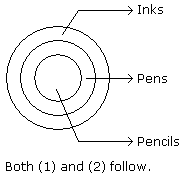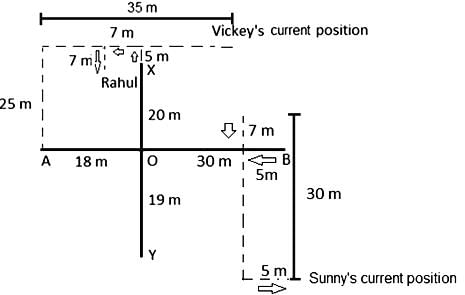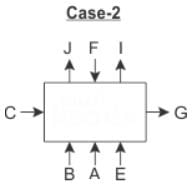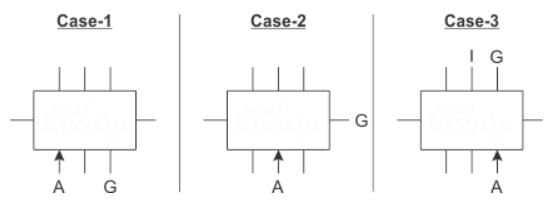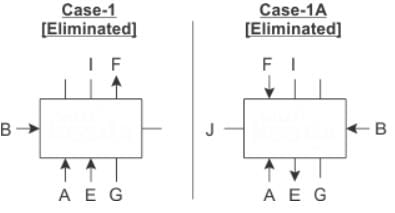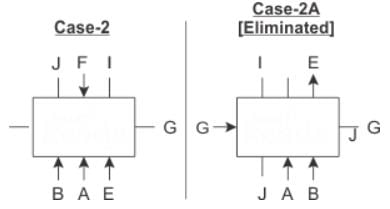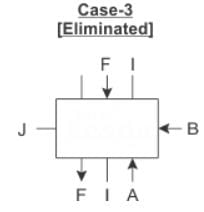Air Force Group Y Mock Test - 7 - Airforce X Y / Indian Navy SSR MCQ
30 Questions MCQ Test - Air Force Group Y Mock Test - 7
Find out the Synonym of the following word:
QUARANTINE
He couldn't but help / shedding tears at the plight of the villagers / rendered homeless by a devastating cyclone / No error.
In the following questions four alternatives are given for the idiom/phrase italicised and underlined in the sentence. Choose the alternative which best expresses the meaning of idiom/phrase.
Q. Since he knew what would happen, he should be left to stew in his own juice.
The first problem to be tackled was that of feeding the huge population of the country after Independence. It became (1)____ to adopt (2)____for agricultural development. The (3)____ of multipurpose (4)____with the development of (5)____ as one of its (6)____ components was the (7)____ step towards the provision of (8)____ infrastructure. It was realised that (9)____ is the basic (10)____ in developing agriculture. The total irrigation potential was, therefore, increased.
Q. Find the word most appropriate for Blank no. 10
In the United States, a larger percentage of the defense budget is spent on developmentof an anti-missile shield than is spent on nuclear missile technology inthe People’s Democratic Republic of North Korea.
Statisticians from the Department of Motor Vehicles have calculated that one human being should be struck every three minutes by a vehicle, while each minutetwo animals can be expected to die from such collisions.
Direction: In each of the questions given below, a sentence is given with two blanks. From the given options, choose the one that gives the correct combination of words that fit in the blanks.
Delivery partners are ____________ made to understand the practical ____________ of the job as they choose to enter the workforce.
Direction: The sentences given in the question, when properly sequenced, form a coherent paragraph. Each sentence is labeled with a letter. Choose the most logical order of sentences from the given choices to construct a coherent paragraph.
A. In 17th-century Amsterdam, it was highly common for the guilds to commission portraits of themselves wearing their uniforms and holding weapons.
B. It was Rembrandt’s riveting interplay of light, motion, texture and expression transformed a commonplace commission into a masterwork.
C. Its status and critical acclaim, though, have little to do with its subject matter: a civic-guard group tasked with keeping watch on the city walls.
D. The painting Militia Company of District II Under the Command of Captain Frans Banninck Cocq, better-known as The Night Watch, is probably Rembrandt’s most famous work.
Direction: The sentences given in the question, when properly sequenced, form a coherent paragraph. Each sentence is labeled with a letter. Choose the most logical order of sentences from the given choices to construct a coherent paragraph.
A. The quest to define units of measurement using constants of nature goes back to the creation of the metric system during the French Revolution.
B. It was a utopian project, with its creators imagining that a shared system of weights and measures would unite the world, allowing for the free exchange of goods and information.
C. The metric system was created with the intention of liberating the common man and woman from the confusing and inconsistent weights and measures of the old regime.
D. At this time, the ideology of liberty, equality, fraternity was embraced not just by revolutionaries, but by scientists as well.
Direction: Read the following passage carefully and answer the following questions.
The Bureau of Indian Standards (BIS) has kicked off the process to set new standards to measure quality of services offered to consumers across different sectors, including telecom, aviation, e-commerce and healthcare.
The BIS, which sets the quality regulations for various products from gold to bottled water, on Friday called a meeting of industry bodies to “persuade them to be part of the process and give their inputs.”
“Service sector is one of the key sectors of the Indian economy with a huge potential to grow into one of the largest markets of the world. Standards can play a major facilitative role in this regard. It is important that the standardisation needs and priorities of the sector are determined,” a senior official said.
During the meeting, the BIS pointed out that the initial focus will be the 12 champion services sectors identified by the government. These include IT, tourism and hospitality, transport and logistics, accounting and finance services, legal services, communication services and construction.
The Bureau of Indian Standards (BIS) standards is set to formulate a framework for quality services that should be provided to consumers and also talk about the benchmarks to deal with consumer complaints or after sales service in an effort to ensure quality in the services sector.
At a meeting with industry bodies on Friday, it has been decided that the BIS will set up a separate ‘divisional council’ for services in a month’s time. Under this, different technical committees will be set up — one for each service. The committees will have various stakeholders such as government officials, experts and industry representatives.
The process was initiated after concerns over lack of standardisation, particularly with regards to after-sales service, in their feedback to the Ministry of Consumer Affairs.
In a poll, online community network LocalCircles found that in the absence of defined customer service standards in the country, a majority of consumers were not happy with after-sales services. As per the poll, 43% feel that mobile handset and computer manufacturers are the worst in after-sales services, followed by white goods firms (38%) and automobile companies (11%). About 93% of respondents said brands should at least acknowledge complaints from users within 72 hours. “Many consumers complained that customer service numbers of many companies do not work,” according to LocalCircles.
Q. Which among the following is the appeal made by the Bureau of Indian Standards to the industry bodies in the country?
Direction: Read the following passage carefully and answer the following questions.
The Bureau of Indian Standards (BIS) has kicked off the process to set new standards to measure quality of services offered to consumers across different sectors, including telecom, aviation, e-commerce and healthcare.
The BIS, which sets the quality regulations for various products from gold to bottled water, on Friday called a meeting of industry bodies to “persuade them to be part of the process and give their inputs.”
“Service sector is one of the key sectors of the Indian economy with a huge potential to grow into one of the largest markets of the world. Standards can play a major facilitative role in this regard. It is important that the standardisation needs and priorities of the sector are determined,” a senior official said.
During the meeting, the BIS pointed out that the initial focus will be the 12 champion services sectors identified by the government. These include IT, tourism and hospitality, transport and logistics, accounting and finance services, legal services, communication services and construction.
The Bureau of Indian Standards (BIS) standards is set to formulate a framework for quality services that should be provided to consumers and also talk about the benchmarks to deal with consumer complaints or after sales service in an effort to ensure quality in the services sector.
At a meeting with industry bodies on Friday, it has been decided that the BIS will set up a separate ‘divisional council’ for services in a month’s time. Under this, different technical committees will be set up — one for each service. The committees will have various stakeholders such as government officials, experts and industry representatives.
The process was initiated after concerns over lack of standardisation, particularly with regards to after-sales service, in their feedback to the Ministry of Consumer Affairs.
In a poll, online community network LocalCircles found that in the absence of defined customer service standards in the country, a majority of consumers were not happy with after-sales services. As per the poll, 43% feel that mobile handset and computer manufacturers are the worst in after-sales services, followed by white goods firms (38%) and automobile companies (11%). About 93% of respondents said brands should at least acknowledge complaints from users within 72 hours. “Many consumers complained that customer service numbers of many companies do not work,” according to LocalCircles.
Q. Which among the following is true regarding the standardization drive to be initiated by the Bureau of Indian Standards?
I. It will focus on the services sector and all the services will be focused under this new initiative
II. The main reason for initiating this drive is the servicing post sales of any product
III. This standardization will focus on framing a benchmark for the quality of service in the country
Direction: Read the following passage carefully and answer the following questions.
The Bureau of Indian Standards (BIS) has kicked off the process to set new standards to measure quality of services offered to consumers across different sectors, including telecom, aviation, e-commerce and healthcare.
The BIS, which sets the quality regulations for various products from gold to bottled water, on Friday called a meeting of industry bodies to “persuade them to be part of the process and give their inputs.”
“Service sector is one of the key sectors of the Indian economy with a huge potential to grow into one of the largest markets of the world. Standards can play a major facilitative role in this regard. It is important that the standardisation needs and priorities of the sector are determined,” a senior official said.
During the meeting, the BIS pointed out that the initial focus will be the 12 champion services sectors identified by the government. These include IT, tourism and hospitality, transport and logistics, accounting and finance services, legal services, communication services and construction.
The Bureau of Indian Standards (BIS) standards is set to formulate a framework for quality services that should be provided to consumers and also talk about the benchmarks to deal with consumer complaints or after sales service in an effort to ensure quality in the services sector.
At a meeting with industry bodies on Friday, it has been decided that the BIS will set up a separate ‘divisional council’ for services in a month’s time. Under this, different technical committees will be set up — one for each service. The committees will have various stakeholders such as government officials, experts and industry representatives.
The process was initiated after concerns over lack of standardisation, particularly with regards to after-sales service, in their feedback to the Ministry of Consumer Affairs.
In a poll, online community network LocalCircles found that in the absence of defined customer service standards in the country, a majority of consumers were not happy with after-sales services. As per the poll, 43% feel that mobile handset and computer manufacturers are the worst in after-sales services, followed by white goods firms (38%) and automobile companies (11%). About 93% of respondents said brands should at least acknowledge complaints from users within 72 hours. “Many consumers complained that customer service numbers of many companies do not work,” according to LocalCircles.
Q. Which among the following will be framework for standardization initiative of the Bureau of Indian Standards with regard to the services sector?
Directions: Out of the given alternatives, choose the one which can be substituted for the given words/sentence.
A list of explanations of rare, technical or obsolete words
The Lahore Session of the Indian National Congress (1929) is very important in history because
- The Congress passed a resolution demanding complete independence.
- The rift between the extremists and moderates was resolved in that session.
- A resolution was passed rejecting the two-nation theory in that session.
Which of the statements given above is/are correct?
The HCF and LCM of two numbers is 84 and 840 respectively. If the first number is 168, find the second one
Directions to Solve
In each of the following questions, five words have been given out of which four are alike in some manner, while the fifth one is different. Choose the word which is different from the rest.
Question -
Choose the word which is different from the rest.
Directions to Solve
In each of the following questions two statements are given and these statements are followed by two conclusions numbered (1) and (2). You have to take the given two statements to be true even if they seem to be at variance from commonly known facts. Read the conclusions and then decide which of the given conclusions logically follows from the two given statements, disregarding commonly known facts.
Question -
Statements: All the pencils are pens. All the pens are inks.
Conclusions:
- All the pencils are inks.
- Some inks are pencils.
Cathode rays when obstructed by metal cause emission of -
The mountain range which divides the North and the South India is–
Which of the following is/are the objectives of the Debt Management Strategy of Government of India?
1. To mobilise borrowings at low cost while keeping the risks at prudent levels.
2. To maintain a stable and sustainable debt structure so as to ensure financial stability.
3. Development of a well-functioning domestic bond market.
Select the correct answer using the code given below.
Umesh purchased 360 eggs at the rate of 78 paise each. On this, he paid Rs. 14 as octroi, Rs. 13 as transport and Rs. 5 as additional charges. He kept 7 eggs for himself. At what rate should he sell each of the remaining eggs to get a total profit of Rs. 70?
Directions: Study the following information and answer the question given below it.
There is an XY axis in such a way that X is in north and Y is in south direction. There is an AB axis in such a way that A is in west direction and B is in east direction. AB axis and XY axis intersect at a point O in such a way that XO is 20 m, OY is 19 m, OA is 18 m and OB is 30 m. Sunny starts from point B and walks 5 m towards west, then turns to his right and walks 7 m, then walks 30 m in south direction, and finally turns to his left and walks 5 m. Vickey starts from point A and walks 25 m in north direction, and then turns right and walks 35 m in east direction. Rahul starts from point X and walks 5 m in north direction, then turns to his left and walks 7 m, and again turns to his left and walks 7 m.
Q. Point Y is in which direction with respect to Sunny's current position?
Which railway station received the 'Green Railway Station Certification'?
Who has been sworn in as Latvia's first openly gay president and the first openly gay president of an EU member state?
Which organization did Edgars Rinkevics vow to support and uphold during his inauguration speech as Latvia's president?
Direction : Study the following question carefully and choose the right answer.
Q: If EARTH can be coded as ‘IUSBF’ how can GLOBE be coded?
Directions: Read the following information carefully and answer the questions given beside.
Eight persons viz. A, B, C, E, F, G, I and J sit around a rectangular table such that three persons sit on each longer side and one person sits on each shorter side. Nobody sits at the corners. The persons whose name starts with vowel do not sit on the shorter side of the table. Three of them face away from centre while the rest five face towards the centre.
B, who faces centre sits second to the left of E. J is on the immediate right of F, who is at a gap of two persons from E. Neither C nor A face away from centre. The immediate neighbors of F face away from centre. G is second to the right of A. I is on the immediate left of F. I is neither adjacent to A nor to C. E is adjacent to G.
Q. Which of the following statements is true?



